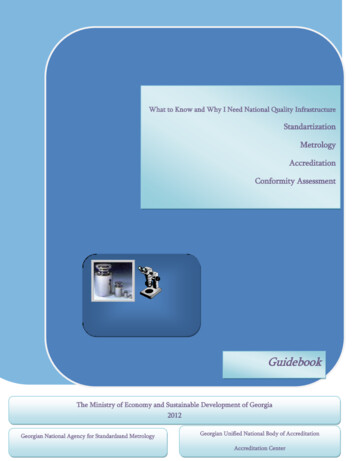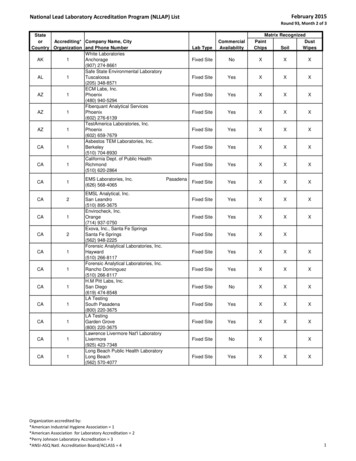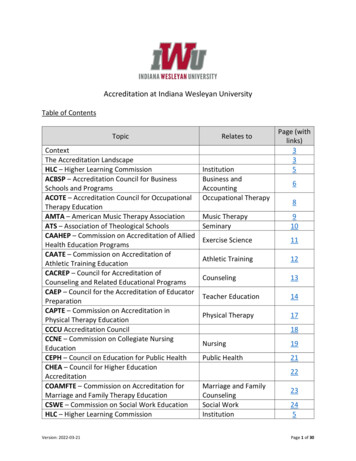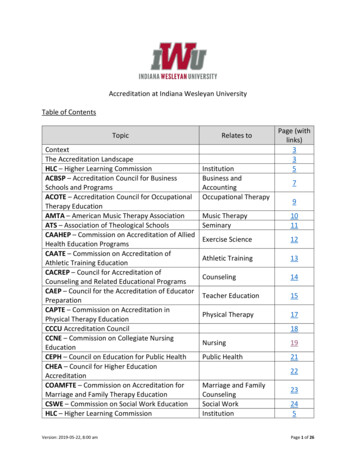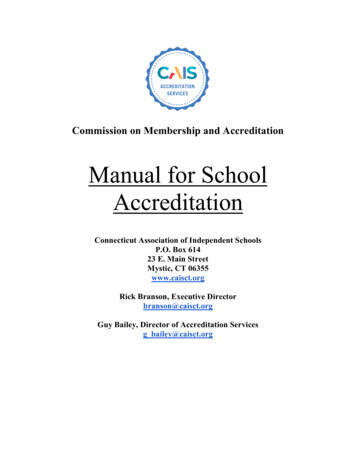
Transcription
Commission on Membership and AccreditationManual for SchoolAccreditationConnecticut Association of Independent SchoolsP.O. Box 61423 E. Main StreetMystic, CT 06355www.caisct.orgRick Branson, Executive Directorbranson@caisct.orgGuy Bailey, Director of Accreditation Servicesg bailey@caisct.org
About CAISThe Connecticut Association of Independent Schools (CAIS) is a member in good standing ofthe International Council Advancing Independent School Accreditation (ICAISA), formerly theCommission on Accreditation of the National Association of Independent Schools (NAIS).In addition, CAIS is recognized by the Connecticut State Board of Education as an officialaccrediting agency. Accreditation by CAIS is coterminous with Connecticut State accreditation.The CAIS accreditation process has been thoroughly reviewed by ICAISA, a nonprofitassociation with 19 member accrediting agencies, representing schools in the United States andthroughout the world. The primary purpose of the Council is to provide quality assurance andaccountability for the accreditation programs of its state, regional, and international independentschool member associations.Although ICAISA itself does not accredit individual schools, its 19 accrediting members,including CAIS, have been accrediting schools for decades. ICAISA has set high standards foraccreditation to which it holds each member association accountable.Criteria for effective practice with which all members must comply were agreed upon, modelstandards were developed to serve as a point of reference, and a system of peer review wasestablished to assure quality and support improvement. CAIS received certification from theNAIS Commission on Accreditation in 2017.It is the mission of CAIS to serve both independent education and the children and families ofConnecticut by: working to foster independence and freedom of choice in education giving leadership and support to member schools in their pursuit of excellence, access,diversity and accountability fostering collaboration among member schools, and cooperation with other educationalorganizations and the public sphere providing appropriate services in keeping with models of practice for each aspect of school life.2
The Manual for School Accreditation has been developed by The Connecticut Association ofIndependent Schools with the cooperation and contributions of the New England Association ofSchools and Colleges and the International Council Advancing Independent SchoolAccreditation.Table of ContentsPageWhat is Accreditation?The Value of AccreditationIntroductionThe Standards for Accreditation and Indicators4567The Self Study ProcessGuide for the Self StudySchool Data SheetFaculty Preference QuestionnaireSuggested Calendar for Self StudyStaff Information SheetAlphabetical Staff Overview222627303336Sample QuestionnairesParentFacultyStudentsSupplementary Materials InventoryVisiting Team ProcessCAIS Website-Accreditation3839404142453
What is Accreditation?Independent school accreditation is a peer-review process that fosters excellence in education andencourages school improvement through discovery, dialogue, compliance, and commitment.Accreditation enables a member school to develop clearly defined goals and objectives based onits mission and philosophy.Accreditation is both a process and a status. It is the process of reviewing schools and theirprograms to assess their educational quality – how well they serve students and society. The resultof the successfully completed process is the designation of “accredited” status.Schools use common practices, including a Self Study to demonstrate compliance with thestandards, an on-site visit by an evaluation group of peer experts, and a subsequent review anddecision by the accrediting body about accredited status. This review is repeated every ten yearsif the institution or program is to sustain its accreditation.An established accrediting organization, such as CAIS, is subject to external review, a processcalled “recognition.” This involves periodic examination of the organization by the InternationalCouncil Advancing Independent School Accreditation (ICAISA), based on a set of standards.4
The Value of AccreditationThe accreditation process is designed to assist a school in engaging the energies of all communitymembers in reviewing and clarifying the School's purpose and goals for students, and indeveloping plans to accomplish these goals. The School also develops measurements that showthe degree to which its goals for students are achieved. Because each school community is unique,the accreditation process permits the School to use considerable flexibility in its approach to theSelf Study, yet still be linked to sound components of a quality self-assessment.Through the completion of the accreditation process, schools will have: Involved the School community in a collaborative way; Clarified the School's purpose and its goals for its students - and the programs, people, andfacilities that support them; Assessed all aspects of the School's operations, the student program and its impact on studentpersonal and academic growth with respect to the criteria and standards; Received a cogent, forthright, and detailed written report from a team of trained andexperienced peer educators and administrators that will serve as future planning guidance, aswell as an accountability system for monitoring the School’s improvement plans; Assured that students and the public can expect that a school or program lives up to itspromises and confidence may be held in the worth of a school and its programs; Provided students validation of expectations of quality for transferring credits, application tocolleges and universities, and possible eligibility for financial aid; Confirmed that the public presentation of an educational program, student services andgraduate accomplishments is fair and accurate; and additionally Assured that the Connecticut Association of Independent Schools has reviewed the quality ofeducation provided and has found it to be not merely satisfactory, but exemplary, based uponthe association’s standards for excellence and appropriate peer expertise.5
IntroductionThe Manual for School Accreditation is designed to give specific attention to each of the dualpurposes of accreditation: quality assurance and school improvement.The Commission on Membership and Accreditation (CMA) has established sixteen standards ofquality assurance that all schools must meet. Initial accreditation of schools will be tabled untilcompliance is documented; member schools may be given one year to bring themselves intocompliance with any standard that is not met at the time of the visit.Part I of the Self Study asks the School to demonstrate its compliance with regard to eachstandard and rate its level of compliance.Part II of the Self Study: Reflection, Recommendations, and Issues for Future Discussion asksthe School to reflect on the findings of Part I, make recommendations for itself that are actionoriented, and identify issues for further discussion that will extend important conversationsgenerated by the Self Study.IMPORTANT NOTE: CAIS now uses the Google platform to assistwith the accreditation process. The school will be provided with all ofthe essential materials (Self-Study Manual and Template, etc.)in aGoogle folder. Similarly, CAIS will share with the Visiting Team thetemplate for the report and other necessary documents. All writtendocuments and communication will be shared electronically.6
The Standards for Accreditation and IndicatorsStandard 1 (Mission): There is congruence between the School’s stated mission and corevalues and its actual program, policies, planning, and decision-making at both theoperational and governance levels.Sample Indicators:1.a The School has a clear statement of educational mission. The stated mission andphilosophy guide the School’s admissions, programming, planning, and decision-making.1.b The mission of the School is congruent with principles of academic scholarship, permittingand encouraging freedom of inquiry, diversity of viewpoints, and independent and criticalthinking.1.cThe mission of the School is embraced by all constituencies.1.d The mission statement is reviewed regularly, using a process that involves representativesof major constituencies of the School, as appropriate.1.e The School community is engaged in reflecting on ways to enrich the application of themission in all aspects of the program.1.f The School’s climate and culture support an effective educational program, consistent withits stated mission.1.g Requirements and expectations of students, parents, faculty, trustees, and employeesclearly reflect the values and mission of the School.1.h The culture of the School reflects a commitment to implementing the mission of theSchool.7
Standard 2 (Governance): The School has an appropriate system of governance thatassures that the School remains true to its mission and that it has the necessary resources tosupport its present and prospective operations.Sample Indicators:2.a The governance of the School is clearly defined, understood by all constituents, andprovides for: continuity of missionstability and ethical process in transitions of leadershipa comprehensive, multi-year planning processassurance of adequate financial resourcesinstitutional advancement/developmentevaluation of and support of the professional growth of the Head of Schoola model of inclusive decision-making for the School communityestablishing and monitoring needed school policiesclearly defined and regularly applied procedures to orient, educate, and evaluate thegoverning bodyrisk management and school safetypolicies related to environmental sustainability2.b Provision is made for participation of all constituencies in the policy-making process, asappropriate.2.c The governing body demonstrates and clearly communicates its commitment to themission, and consistently exercises its fiduciary responsibilities.2.dThe governing body provides opportunities for generative thinking on a regular basis.2.e The School has a current Multi-Year Plan that integrates all school operations, programs.and finances, as well as timelines for implementation.2.f There is an understood delegation of decision-making that gives the Head of School thecapacity to exercise effective educational leadership.2.g The governing body, in conjunction with the School’s administration, provides for stabilityand continuity in the event of short and long-term periods when classes are unable to be held oncampus and there is a necessity for distance (virtual and/or hybrid) learning experiences.8
Standard 3 (Diversity, Equity, Inclusion, and Justice): The School has created andcontinues to foster a program, culture and inclusive community of students, families,trustees, teachers and staff who embrace the multitude of perspectives, cultures,backgrounds and identities in our world.Sample Indicators:3.a Issues of equity, diversity, inclusion, and justice are defined and incorporated into theSchool’s program, policies, planning, and decision-making at both the operational andgovernance levels.3.b The School articulates the value of diversity, equity, inclusion, and justice to itscommunity.3.c The School attends to the quality of life of all members of the community and takes actionsto create an equitable, inclusive, safe, and just environment.3.d The governance of the School is clearly defined, understood by all constituents, andprovides for: a model of inclusive behavior and integrity for the School community3.e The governing board establishes policies that reflect diversity, equity, inclusion, and justiceand ensures that these qualities are reflected in decision-making and governing bodymembership.3.f The School has defined what constitutes a diverse student body.3.g The School, in harmony with its mission and resources, seeks, admits, and supports adiverse student body and creates educational and co-curricular programs that provide equalaccess for all students regardless of social identity, national origin, and/or citizenship status.3.h The program offers a variety of cultural experiences to reflect (a) the diversity of studentsenrolled and (b) the multicultural nature of the region, country, and world.3.i The School’s teaching practices, curriculum, and broader educational program reflect acommitment to diversity, equity, and inclusion and social justice.3.j The School is mindful of the ways in which families of different identities, backgroundsand socio-economic statuses may be affected by School policies and programs.3.k There is an evaluation process in place to see how the School’s programs need to change toreflect the diversity of the School community and the world.3.l The School recognizes and validates differences within the student body such as genderand gender identity, learning style or ability, race, age, ethnicity, family background, socioeconomic status, sexual orientation, and religious practice.9
3.m Time is made available on a regular and consistent basis for teachers to learn ways inwhich their cultural backgrounds and life experience help or hinder their ability to plan togetherto work with students, parents, and other adults in the community.3.n There is a process in place to see how the School’s programs need to change to identifystudents who will need additional support to function effectively in a pluralistic environment.3.o The School promotes and has ways to ensure an equitable, just, and inclusive communitywhere students respect and value diversity and are active and responsible.3.p Faculty and staff, School leadership, and members of the Board of Trustees are regularlytrained in the current topics, language, and academic content related to racism, discrimination,and other issues of diversity, equity, inclusion, and social justice.3.q The School has defined what constitutes a diverse staff in accordance with the School’smission.3.r The School has processes in place to recruit, hire, and support a diverse staff.3.s The School develops and publishes a policy and plan on diversity, equity, inclusion, andjustice, derived from its mission and core values that it uses to evaluate the status of the Schoolin this regard and to guide planning to achieve goals.3.t The School structures ways to work with parents/guardians proactively. The School ismindful of the ways in which families of different backgrounds and socio-economic status maybe affected by School policies and programs.3.u In marketing materials and other outward facing communications, the School demonstratesits commitment to diversity, equity, inclusion, and justice.Standard 4 (Program): The School provides a comprehensive program of intellectual,aesthetic, and physical activities that stems from the School’s beliefs about teaching andlearning, is appropriate to support its mission and core values, and effectively addresses theneeds of the range of students admitted. Program planning is informed by relevantresearch regarding how students learn and the knowledge and capacities they will need tolead purposeful and constructive lives.Sample Indicators:4.a The educational program stems from the School’s beliefs about teaching and learning thatare regularly reviewed and that are consistent with the mission of the School.4.b The School programs demonstrate consideration for the appropriate intellectual, social,physical, aesthetic, emotional and ethical development of students in all aspects of school andstudent life.4.c. The curriculum demonstrates continuity from year to year.10
4.d. The School has a policy for regularly reviewing the academic program and has completed arecent, written Curriculum Plan outlining desirable and/or necessary improvements.4.e Attention is paid to transitions between grade levels and/or divisions of the School so as tofacilitate passage of students from one level/division to another.4.f. The School recognizes developmental levels of children and takes them into considerationin planning programs and teaching methodologies.4.g The School evaluates the academic rigor, effectiveness, and integrity of online courses thatits students take, and of any online courses that the School itself offers, on a regular basis.4.h The School strives to promote a culture of global understanding that is appropriate to theSchool’s mission, size, and means.4.i The School promotes a commitment to environmental responsibility and stewardship forcurrent and future generations that is appropriate to the School’s mission.4.j The School’s program is able to provide mission-driven opportunities to all of its students,as appropriate for distance (virtual/ hybrid) learning experiences.Standard 5 (Early Childhood Program): The Early Childhood Program enriches thesocial, intellectual, and developmental needs of its students by providing appropriateprograms, adequate staffing, and sufficient resources and facilities.Sample Indicators:5.a The School communicates and collaborates with parents of children in its Early ChildhoodProgram in a manner which addresses the needs of this community.5.b Staff who work directly with children in the Early Childhood Program are trained in thefield of early childhood education/child development. Their numbers are sufficient in relation tonumbers and ages of children in each early childhood grouping to perform tasks effectively andsafely.5.c The School has curricular and extracurricular programs in place which specifically andeffectively address intellectual and developmental needs of children in the Early ChildhoodProgram and are consistent with the School’s stated mission.5.d Facilities provided for the Early Childhood Program, including instructional, activity andplay spaces, and supporting resources such as lavatories and dining areas, are adequate inconstruction, space provided per child, and maintenance to meet the needs of the children in theprogram.5.e Materials, routines, and procedures are so organized as to protect the health and safety ofyoung children enrolled in the Early Childhood Program.11
5.f Those sections of the Early Childhood Program that serve children under the age of threemeet state health and safety guidelines for approval of child care facilities.5.g Realizing the unique needs of pre-school children and their parents concerning thedemands of distance (virtual and/or hybrid) learning experiences when classes are unable to beheld on campus, the School develops age-appropriate plans to meet these needs.Standard 6 (Residential Program and/or Homestay Program): The residential programand/or Homestay Program provides for an intentional curriculum, appropriate facilities,engaging activities, and adequate supervision to meet the needs of each student.Sample Indicators:Residential Programs:6.a The School ensures that boarding personnel receive specific training, supervision, andevaluation so as to be qualified to meet the needs of students under their care and supervision.6.b The residential program is consistent with the mission of the School, and is integrated intothe total life of the School, especially with regard to the interaction with day students.6.c The School promotes environments that provide opportunities to enhance positiveinteraction among domestic and international students, and to develop sensitivity andunderstanding regarding cultural differences and needs that are specific to international students.6.d Evening, weekend, and vacation activities are actively planned, as part of the residentialcurriculum, to meet the needs of the students.6.e The School provides for the needs of international students, students with limited financialresources, and students who have difficulty adjusting to being away from home.6.f If technological services, such as computers, Internet access, email, and/or telephones, areincluded in residential areas, there is a process to ensure that policies and procedures areconsistent with the School’s overall Technology Plan and Acceptable Use Policy.6.g Through a well-defined process involving students, parents, and staff, a regular review ofthe residential program is accomplished which is intended to lead to revisions and/orimprovements.6.h There are clearly-stated, written, and understood expectations for residential students andstaff.6.iStudents are included in planning and developing policies, expectations, and programs.12
Homestay Programs:6.jThe homestay program is consistent with the mission of the School.6.k The School has a formal contract with homestay families if there is a direct placement orwith an agency that provides homestay placements.6.l The School assures that homestay facilities are safe and clean, and provide sufficient livingspace.6.m There is a clearly defined process to screen host families, including a background checkand a process for matching student and family interests.6.n There is a procedure to include host families and students in defining and understanding theethical and legal responsibilities of the School, host families, and students.6.o The School has clearly stated, written, and understood expectations for the School, hostfamilies, and students regarding the academic program and experiences both during the Schoolweek and on weekends and vacations, and these expectations and responsibilities are publishedand disseminated in a school handbook.6.p The School has a well-defined process, which includes students and host families, toregularly review the homestay program and the experience of the students for the purpose ofimprovement.Standard 7 (Resources to Support the Program): Given the School’s mission, there areadequate resources (space, equipment, technology, materials, and community) to supportthe School’s program.Sample Indicators:7.a Instructional facilities (including space, furnishings, and play/recreation areas) are adequatefor the instructional program and are age appropriate.7.b There are instructional materials and equipment in sufficient quality, quantity, and varietyto give effective support to the aims and methods of the program.7.c The School has a Library Plan which is integrated with the curriculum and which providesstudents with age appropriate experiences in research and reading and supports the broadpurposes of the educational program.7.d The School has a written Academic Technology Plan, developed by teachers and academicleaders, covering the integration of technology into the various components of the program andproviding for the professional development of teachers in the implementation of this plan.13
7.e The School has in place an Acceptable Use Policy of which students and families areinformed and the School provides information to students and families on the appropriate andethical use of technology.7.f There are procedures in place to assure that teachers have a leading role in planning the useof technology in their teaching.7.g Non-academic programs, if available, are consistent with the School’s mission and are wellorganized, supplied, and staffed.7.hThe schedule is planned by day and year to provide for the total program.7.i The School interacts with the community in which it is located and avails itself ofcommunity resources.7.j The School strives to be a positive member of the community in which it exists, is sensitiveto the interests of its neighbors, and takes appropriate advantage of the character of its setting.7.k The financial aid resources committed to students and their families reflect the goals andmission of the School.7.lThe School has sufficient resources to support any online courses that it offers.7.m The School provides the necessary technological infrastructure to accommodate itsfaculty, staff, and students with the ability to succeed when there is a necessity for distance(virtual/hybrid) learning experiences.Standard 8 (Experience of the Students): The School actively considers individual studentsand has developed plans, policies, programs, and pedagogy to nurture, support, andencourage all students to reach their potential and to participate in the life of the School.Sample Indicators:8.a Time is made available on a regular basis for teachers to plan together and to discussstudents (both individuals and groups).8.b There is a procedure in place to assess and report on how individual students are meetingthe goals of the program with regard to both personal and academic growth.8.c Resources are available to faculty (in-school or through outside consultants) to assist inidentifying and meeting the needs of individual students.8.d There is a process in place to identify students who might benefit from a modification ofthe program.8.e There is a process in place to identify students for whom the School is inappropriate and asupportive process for counseling those students.14
8.f Counseling, advising, and guidance procedures and personnel address the needs of thestudents.8.g The School ensures that homestay host families receive specific training, supervision, andevaluation that address the needs of international or other guest students.8.hCollege or school placement counseling, as applicable, addresses the needs of the students.8.i Information is systematically gathered regarding students’ experience at the School and isused to inform program planning.8.j The School assures that the design and delivery of online courses that its students take orthe School offers meet the needs of the students and support student-to-student and student-toteacher interactionsStandard 9 (Faculty): The School ensures that there are sufficient and trainedadministrators, faculty and staff members dedicated to supporting students and theirfamilies across all cultures. The School follows a comprehensive and defined program ofprofessional development that supports continued enhancement of teachers’ skills.Sample Indicators:9.a The School has a procedure for recruiting professional staff who are the best available forthe tasks to be performed and for the mission of the School; and also has a procedure forscreening and interviewing candidates and providing them with necessary backgroundinformation about the School.9.b Academic personnel are qualified by education, training, or experience in the areas towhich they are assigned.9.c. Personnel practices provide ethical treatment among all faculty, administration, and staffwith respect to compensation, workload, and working conditions.9.d The School demonstrates a commitment to staff development by providing opportunity forand expecting participation in professional growth and development.9.e Professional development time is used for faculty to discuss issues of teaching andlearning.9.fThe School has a shared understanding of teaching excellence.9.gThe School has a defined program for the evaluation and supervision of teachers.9.h The faculty are treated with respect and the School sets clear expectations for theirprofessional behavior.9.i If the School offers online courses, faculty responsible for providing these courses areappropriately qualified, trained, supported, and evaluated.15
9.j In the event of unanticipated distance (virtual and/or hybrid) learning, teachers have beenprepared, in advance, to pivot from one mode of teaching to another.9.k Teachers are provided training to become familiar with and able to provide mission-driven,distance (virtual and hybrid) learning experiences.Standard 10 (Administration): The administration provides leadership and maintains astructure to facilitate the effective functioning of the School, including the participation offaculty in decision-making.Sample Indicators:10.a The administration is effective in carrying out the program of the School and the policiesestablished by the governing body or school board.10.b Administrative personnel and support staff are qualified by education, training orexperience to serve in the areas to which they are assigned.10.c The administration assures review and evaluation of the educational program and providesthat a current Curriculum Plan is in place.10.d On an annual basis, the appropriate school personnel review and approve all proceduralplans to be implemented in the event of short and long-term periods when classes are unable tobe held on campus and there is a necessity for distance (virtual and/or hybrid) learningexperiences.10.e The School involves faculty in decision-making about the program of the School.10.f The School demonstrates a commitment to administrator development by providingopportunity for and expecting participation in professional growth and development.10.g The School has a defined program for the evaluation and supervision of administrators.10.h The school ensures equal opportunity for its students and families in their ability to accessand benefit from distance (virtual and/or hybrid) learning experiences.Standard 11 (Communication): The School maintains effective systems of external andinternal communication and record keeping that inform all constituents and facilitateparticipation.Sample Indicators:11.a The School publishes current school policies and procedures in handbooks or makes themreadily available in other forms to the affected constituencies.16
11.b There is an internal communication system to distribute minutes of meetings, give notice ofdecisions, and inform the School community of events and other news.11.c The School has a mechanism in place for input from staff into decision-making regardingpersonnel policies, budget preparation, and other areas, as appropriate.11.d Information regarding the financial responsibilities of the parent/guardian or student to theinstitution is clearly stated in writing and is made available prior to enrollment.11.e There is a procedure for determining equitable adjustments in tuition and other financialobligations existing between the parent/guardian and the institution.1
Council Advancing Independent School Accreditation (ICAISA), based on a set of standards. 5 The Value of Accreditation The accreditation process is designed to assist a school in engaging the energies of all community members in reviewing and clarifying the School's purpose and goals for students, and in developing plans to accomplish these .







